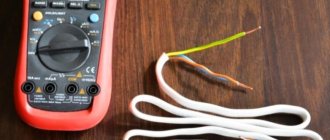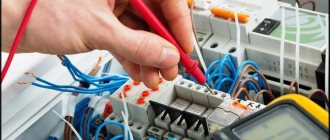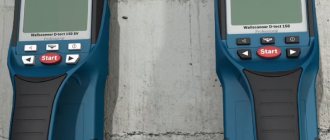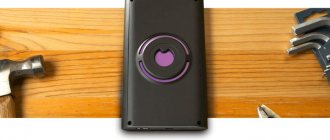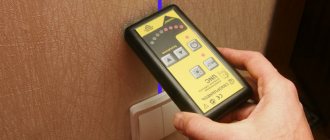During repair and construction work, you need to know about the location of electrical wiring, reinforcement and other elements in the walls, floor and ceiling.
will help you avoid scoring or drilling with unpredictable consequences .
In this review, we will look at the best hidden wiring detectors and analyze the criteria for choosing equipment of this type.
Page navigation:
What is useful to know in advance
There are several types of devices for finding cables and wires in walls.
The price of wiring scanners ranges from 700 to tens of thousands of rubles. To make a choice, you do not have to rely on the seller's advice without having your own opinion. Any seller wants to sell goods at a higher price or get rid of stale ones. If you don't know much about the topic, read this article! You will not regret.
The devices use different physical principles and are roughly divided as follows:
- Electrostatic.
- Electromagnetic.
- Metal detector.
- Combined.
- Radar.
- Ultrasonic.
How to avoid 4 mistakes
- When purchasing a finder, you should not immediately buy an expensive device. A high price is not always an indicator of quality products.
- Installation of hidden wiring is carried out in a vertical or horizontal position. The wires run parallel or perpendicular to the floor. Also worth keeping in mind:
- above sockets and switches, the wire runs upward, so you cannot drive nails there;
- as a rule, the line is located around 15 cm from the ceiling or floor; work cannot be carried out here either;
Using this data, you can roughly draw a picture of the route of the wires.
- When choosing a device, you must consider the type of walls:
- if the walls are ordinary and the room is dry, then a regular finder will do;
- if the walls are metal, or the search will be carried out in special rooms (baths, basement, garage), then a professional searcher is needed.
- After the device is turned on, you need to wait some time for it to calibrate.
Source
Passive detectors (radiation receivers)
These wire detectors respond to the electric or magnetic field of a wire. They are insensitive to de-energized wiring. It is also useless to search for DC wiring with them.
Electrostatic scanner
Reacts to the electric field created by a current-carrying conductor.
The device detects an alternating electric field created near the electrical conductor. Such a scanner will not be able to detect wiring if it is not energized. Voltage can be supplied from a low-power pulse generator. The scanner is used to examine the location of the proposed route and must be brought to the place where the signal is strongest. Signal indicators vary. This could be an LED, a buzzer (“beeper”), or an LCD display. Such a device detects wiring at a distance of up to 10 ... 15 cm, which is quite enough for walls. This is the cheapest type of scanner.
Electromagnetic scanner
Reacts to an alternating magnetic field from a current-carrying wire. Like the previous detector, it only detects wiring if it is live. The sensitivity of this scanner is approximately the same as that of an electrostatic one. The price of both types of devices is approximately the same. Such hidden wiring finders are well suited for home repairs by non-professionals.
Difference between detectors
In an electrostatic finder, the sensing element is a small pin in which a voltage is induced by an alternating electric field. An electromagnetic device uses a coil. An alternating magnetic field induces a current in it. Since the signals are too weak for direct display, they are further amplified by an electronic amplifier.
In principle, both detectors act like a radio receiver. Since the frequency of the alternating current is too low, the sensitivity of such a detector is only sufficient for a very short distance from the wire. But it is quite sufficient for the purpose of searching for wires in thin walls that are not shielded with metal mesh, sheets and other conductive obstacles.
If the wiring is in metal pipes, then it will be impossible to detect it with such detectors. Plaster or wood practically do not present any barriers to the electric or magnetic field.
Expert opinion
Torsunov Pavel Maksimovich
There are diagrams online for homemade assembly of simple wiring detectors, but they will require some knowledge and skills to make. Although this is the cheapest option, it is not suitable for everyone. People for whom time is money will prefer to buy ready-made ones.
Indicator screwdrivers
The simplest detectors of hidden wiring are testers and indicator screwdrivers, cheap and reliable, but not very accurate - it’s really difficult to tell from them whether there is a wire under the plaster or not. Since the screwdriver tester also has other tasks, its detector functions work according to the residual principle. This is an ordinary electrician that works when one circuit is closed (we clamp it, apply it).
The screwdriver works both by touch and by the structure of the materials - so you shouldn’t expect much precision, it depends on the wall.
Separately, I would like to mention a whole class of quasi-detectors built on the same simple non-contact static principle - these are many “fast and cheap indicators”, including everyone’s favorite Woodpecker detector and its Chinese clones. Indeed, the effectiveness of old detectors is no more than that of a screwdriver for 50-60 rubles. There is no point in overpaying and then still getting low accuracy.
Chinese indicator screwdriver for 66 rubles
Active detectors
These devices are more advanced than those already discussed. They cost more, but have additional capabilities and help to find not only wiring.
Metal detector
A metal detector operates differently than the scanners described above.
In essence, this is the device that was previously called a mine detector. Now it's called a metal detector. He finds metal. It doesn't matter whether the metal is energized or not. Devices of this type are quite sensitive, in addition, their sensitivity can be adjusted and fine-tuned to the search conditions.
The principle of operation of the metal detector is as follows. The coil with the wire, which is the sensor, is supplied with high-frequency alternating current from one generator. The device has another generator operating at the same frequency, and this frequency is strictly stabilized. Signals from the coil and the reference oscillator are fed to a mixer, which separates the difference between these frequencies.
When a metal object approaches the sensor coil, the frequency of the first oscillator changes slightly. But due to the fact that this frequency is quite decent, even a small change in it creates a signal of a completely detectable frequency on the mixer. Then it is amplified and displayed on the indicator.
The sensitivity of the device turns out to be very high compared to what we discussed above. But its cost is also several times higher. The advantage of a metal detector is that it can detect metal pipes in which wiring is laid. It also detects wiring, regardless of whether it is energized or not. Of course, he discovers reinforcement embedded in concrete and other metal things located in the walls.
Finders for non-metals
In addition to the magnetic field, active detectors can use an electric field.
They turn out to be sensitive not only to metal, but also to dielectrics, for example, wood. Such a sensor is an “open” capacitor, sensitive to changes in the electric field near its plates. It is also powered by alternating current and also uses the beat method (differences of close frequencies), like a device with a coil.
Combined instruments contain a coil and an electric field sensor simultaneously. All these devices, in the spirit of the times, are equipped with microprocessors that calculate electrical signals from sensors and show the user the result in a human-readable interpretation. For example, the distance to metal objects, the presence of voltage and even its approximate value. Perhaps, such a device can most often be found on the market as a mid-level device at a price of several thousand rubles.
Finally, a few words about the ultrasonic and radar sensor. These are also active devices. The first of them emits ultrasound, exactly like an echo sounder or sonar for submarines. The reflected ultrasound, after amplification, is analyzed by a microprocessor and the user can learn quite a lot about what and how is located inside the material under study.
Metal objects, wood, plastic, various inhomogeneities, all this will be accurately detected. For an accurate and deep search for metals and wires, a real radar is used, only hand-held. This is the most expensive finder; it is used by professional builders in difficult and critical cases.
Tips for using hidden wiring detectors
What cable scanner do you use?
ElectrostaticElectromagnetic
Here are some useful tips:
- The very first piece of advice is to make sure that the battery in it is fresh before using the detector. If this is not the case, then the detection accuracy will be extremely low and you may end up with a drill directly into a live cable or water pipe.
- If you use a generator to supply power to the cable you are testing, be sure to ensure that it is unplugged and that there is no voltage on it! Failure to follow this advice may result in electric shock.
- If you detect a response from the device (it doesn’t matter whether it uses a sound or a light indicator), do not rush to conclusions. Especially if it is an active type device, a metal detector. Examine the route in detail, sketch its location on paper or mark it on the wall with a pencil. Only after analyzing all the data, decide where the pipe or fittings may be, and where the wiring is. Also take into account the entrances of communications in a known place in order to trace their route further.
- Please note that a simple type (passive) wire detector in mains power mode will only show the location of the phase wire. It will not detect the neutral or protective ground if they go separately from the phase wires.
Checking work
In order to accurately determine the location of hidden wires, you should first learn how to use the indicator. To do this, you need to try working with it on open wires, pipes, and other elements. This will help you understand when and to what objects the device emits a signal.
Before making a purchase, you should test the indicator in a store. Any switched on electrical appliance is suitable for this. You can use its wire for testing. The device must be tested at different distances. The wire can be covered with a board or some plastic object. If the detection was successful, then you can safely buy the indicator you like.
Review of several models of wire and metal detectors
Let's start the review with inexpensive models, which often turn out to be the most practical for non-professionals who want to make repairs in their home.
Voltage detector UNI-T UT-12A
This inexpensive and compact device enjoys a good reputation. Price up to 500-600 rub. Despite its simplicity, it reliably detects hidden live wiring. The device is equipped with an audible alarm that can be turned off and guided by an LED indicator that will flash when voltage is detected. If the indicator does not blink, but is constantly on, then this is not a sign of a malfunction of the device, but a sign that it is time to change the battery.
The detector automatically turns off after half an hour of inactivity. Powered by two AAA batteries. Weight 50 g.
Locator Mastech MS6812
The MS6812 Cable Tester and Wiring Detector can locate hidden live wiring. The kit includes a generator that expands the capabilities of the scanner. If you read the article from the beginning, then you know that it makes it possible to search for wiring even without voltage. And besides, you can find the place of the hidden circuit. Or call a separate conductor in the bundle, which is sometimes necessary and is not the easiest task.
This scanner and tone generator included are powered by 9 V batteries. Sound and light indication. The device has good reviews. At a price of about 800 rubles, the buyer acquires a very useful and multifunctional device.
Wiring finder BSIDE FWT11
The FWT11 device is similar to the previous one, but has more useful functions. It is already more addressed to professional buyers. Although its price remains relatively small, this scanner can be purchased for 1700 ... 2500 rubles. The device can detect not only power wiring but also test low-current systems: find breaks, short circuits, and mutual interference of conductors.
Using RJ45 and RJ11 connectors, you can connect LAN and Ethernet cables and test them. It is also possible to connect to cables using crocodile clips. For noisy working conditions, a headphone jack is provided.
The generator and receiver-probe are powered by batteries of size 6F22 9 V (“Krona”). The probe has a built-in LED flashlight, which helps in dimly lit areas.
Characteristics:
| Length of cable: | 300 m |
| Protection class: | IP40 |
| Functions: | tracing, topology, signal generator |
| Dimensions: | 235 x 145 x 51 mm |
| Weight: | 500 g |
Scanner IdeenWelt (Germany)
This device can be classified as a combined device. It includes a coil and a capacitive sensor. Therefore, it can detect wood and plastics. When searching for wiring, such functions will not hurt at all, as they sometimes allow you to get answers to additional questions. The undoubted advantages of the device include ease of handling.
The device provides sound and light indication of detected objects.
Some characteristics are given in the table:
| Wiring Detection: | up to 30 mm |
| Metal Detection: | up to 50 mm |
| Tree Detection: | up to 38 mm |
The price of the device is about 1800 ... 2000 rubles. – it’s quite inexpensive for such a set of functions. Although, there is a suspicion that the device was made in China. European prices will be higher.
Metal detector Einhell TC-MD 50
A combined type device that uses magnetic and electric fields to detect objects. On the reverse side there is a gasket to prevent scratching the walls when searching; you can also use a soft covering. The detector has visual and audio alarms. If the device is not in use, it automatically turns off after 1 minute.
Characteristics:
| Metal Detection (Black): | 50 mm |
| Tree Detection: | 19 mm |
| Metal Detection (Copper): | 38 mm |
| Wiring Detection: | 50 mm |
| Scanner weight: | 150 g |
| Package weight: | 340 g |
The price of the scanner is about 2000 rubles.
Wiring scanner BOSCH PMD 7
Multifunctional scanner for detecting metals, wood and hidden wiring. All metals are detected to a depth of 70 mm, and live wiring is detected to a depth of 50 mm. The detector has a three-color indication (yellow, green, red).
Calibration in the device is automatic, detection occurs in real time. Power is supplied from a 1.5 V element. Weight is only 150 g. The manufacturer (Germany) provides a one and a half year warranty.
Price approximately 4500...5500 rub.
Wiring detector Bosch GMS 120 M
This is a professional grade device. It allows you to detect (live) wiring at a depth of up to 50 mm. Wood is detected to a depth of 38 mm, ferrous metals up to 120 mm and copper up to 80 mm.
The device provides automatic calibration. There is a center detection function. In addition, the ring in the middle is designed to indicate the exact position of the target and make a marker mark on the wall. The switch allows you to select one of three operating modes: wood, metal, wiring.
The scanner display is backlit. The device is powered by a 9 V battery. It has an automatic shutdown function when not used for more than 5 minutes.
Price approximately 7000...8000 rubles.
Cable and metal scanner BOSCH D-Tect 150 Professional
At the end of the review, a professional radar-type device. It detects wiring at a depth of 60 mm. Metals (including steel reinforcement) are found at a depth of 150 mm, pipes - 80 mm. The device weighs about 700 g.
The main advantage of the device is its high accuracy of metal detection up to 1 mm. The display is very informative. This radar does not require calibration and is ready for measurements immediately after switching on.
The only drawback of the device is the price. It costs approximately 37,000...40,000 rubles.
